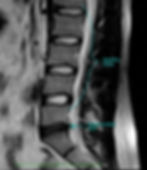
Degenerative Disc Disease
What Causes Degenerative Disc Changes and Chronic Low Back Pain?
Degenerative disc disease (DDD) is a term generally applied to degenerative changes seen in the intervertebral disc in patients that have low back pain. In some people, the affected disc can be the source of pain. Such patients have discogenic low back pain (dLBP). Figure 1 provides an overview of the anatomy of a healthy intervertebral disc.
Figure 3. (Click image to enlarge.)




Figure 1. (Click image to enlarge.)
Figure 2. (Click image to enlarge.)
Figure 4. (Click image to enlarge.)
Healthy discs act as shock absorbers for the spine (Figure 2), allowing movement in multiple directions. At birth, an intervertebral disc is roughly 80% water. As we age, however, degenerative changes occur, including normal wear and tear on the body and its tissues, as well as dehydration of the disc.
For some people, this deterioration, often referred to as degenerative disc disease (DDD), may lead to pain, spinal instability and other symptoms. While DDD can happen anywhere along the spine, it frequently occurs in the lower portion of the back—the lumbar spine. In the event that the disc itself is the source of pain, the patient is diagnosed with discogenic low back pain (dLBP).
The cause of dLBP may be directly related to wear and/or injury sustained by the innermost part of the disc, the nucleus pulposus (NP). This damage can be due to excessive wear and tear from poor biomechanics or as the result of any significant accident or injury. Research indicates that genetics, smoking and obesity may contribute to disc degeneration as well. The damaged disc may lead to inflammation within the NP and micro-tearing of the annulus fibrosus (AF) of the disc, the portion that surrounds and contains the nucleus.
The nucleus tissue has poor blood supply and inflammation takes very long to resolve—if it can be resolved. Compounding the situation is that sensitive nerve endings[ML1] [AM2] can grow into these microtears and render the disc hypersensitive to movements that would not typically cause pain. Other spinal elements, such as ligaments or even adjacent vertebrae, may be affected as degeneration progresses.
It is important to note that although degenerative changes may be observed, the pain may be unremarkable. Conversely, imaging may reveal very mild degenerative changes, yet the patient may be experiencing significant pain.
1
2
2
3
One of the challenges in treating dLBP is making the correct diagnosis. Normal degenerative changes to the disc and other spinal elements are very common and differentiating such changes from pathological manifestations is radiologically difficult and unreliable making a diagnosis of dLBP difficult. As such, dLBP is largely underdiagnosed and many patients with treatable back pain continue to suffer. However, once diagnosed, surgical treatment is often effective if conservative measures fail to provide relief.
There are numerous treatments for dLBP ranging from conservative therapies such as physical therapy and nonsteroidal anti-inflammatory drugs (NSAIDS), to more invasive surgical options such as spinal fusion, total disc replacement, and nucleus replacement in appropriate patients.
See Treatment Options for more information.
1. https://www.spine-health.com/conditions/spine-anatomy/spinal-discs
